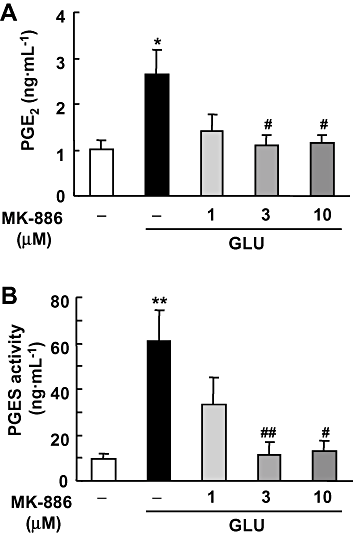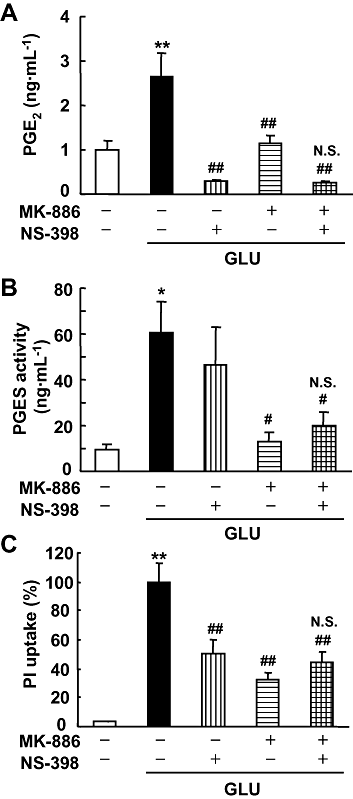Microsomal prostaglandin E synthase-1 and cyclooxygenase-2 are both required for ischaemic excitotoxicity
- PMID: 20128796
- PMCID: PMC2839275
- DOI: 10.1111/j.1476-5381.2009.00595.x
Microsomal prostaglandin E synthase-1 and cyclooxygenase-2 are both required for ischaemic excitotoxicity
Abstract
Background and purpose: Although both microsomal prostaglandin E synthase (mPGES)-1 and cyclooxygenase (COX)-2 are critical factors in stroke injury, but the interactions between these enzymes in the ischaemic brain is still obscure. This study examines the hypothesis that mPGES-1 activity is required for COX-2 to cause neuronal damage in ischaemic injury.
Experimental approach: We used a glutamate-induced excitotoxicity model in cultures of rat or mouse hippocampal slices and a mouse middle cerebral artery occlusion-reperfusion model in vivo. The effect of a COX-2 inhibitor on neuronal damage in mPGES-1 knockout (KO) mice was compared with that in wild-type (WT) mice.
Key results: In rat hippocampal slices, glutamate-induced excitotoxicity, as well as prostaglandin (PG) E(2) production and PGES activation, was significantly attenuated by either MK-886 or NS-398, inhibitors of mPGES-1 and COX-2 respectively; however, co-application of these inhibitors had neither an additive nor a synergistic effect. The protective effect of NS-398 on the excitotoxicity observed in WT slices was completely abolished in mPGES-1 KO slices, which showed less excitotoxicity than WT slices. In the transient focal ischaemia model, mPGES-1 and COX-2 were co-localized in the infarct region of the cortex. Injection of NS-398 reduced not only ischaemic PGE(2) production, but also ischaemic injuries in WT mice, but not in mPGES-1 KO mice, which showed less dysfunction than WT mice.
Conclusion and implications: Microsomal prostaglandin E synthase-1 and COX-2 are co-induced by excess glutamate in ischaemic brain. These enzymes are co-localized and act together to exacerbate stroke injury, by excessive PGE(2) production.
Figures









Similar articles
-
Microsomal prostaglandin E synthase-1 contributes to ischaemic excitotoxicity through prostaglandin E2 EP3 receptors.Br J Pharmacol. 2010 Jun;160(4):847-59. doi: 10.1111/j.1476-5381.2010.00711.x. Br J Pharmacol. 2010. PMID: 20590584 Free PMC article.
-
[The role of prostaglandin E2 in stroke-reperfusion injury].Yakugaku Zasshi. 2013;133(9):947-54. doi: 10.1248/yakushi.13-00171. Yakugaku Zasshi. 2013. PMID: 23995802 Review. Japanese.
-
Endothelial microsomal prostaglandin E synthase-1 exacerbates neuronal loss induced by kainate.J Neurosci Res. 2010 Feb 1;88(2):381-90. doi: 10.1002/jnr.22195. J Neurosci Res. 2010. PMID: 19658194
-
Microsomal prostaglandin E synthase-1 is a critical factor of stroke-reperfusion injury.Proc Natl Acad Sci U S A. 2006 Aug 1;103(31):11790-5. doi: 10.1073/pnas.0604400103. Epub 2006 Jul 24. Proc Natl Acad Sci U S A. 2006. PMID: 16864802 Free PMC article.
-
Characterization of microsomal prostaglandin E synthase 1 inhibitors.Basic Clin Pharmacol Toxicol. 2014 Jan;114(1):64-9. doi: 10.1111/bcpt.12162. Epub 2013 Nov 11. Basic Clin Pharmacol Toxicol. 2014. PMID: 24138533 Review.
Cited by
-
HIV-1 Tat Upregulates TREM1 Expression in Human Microglia.J Immunol. 2023 Aug 1;211(3):429-442. doi: 10.4049/jimmunol.2300152. J Immunol. 2023. PMID: 37326481 Free PMC article.
-
Gut microbiota regulate Alzheimer's disease pathologies and cognitive disorders via PUFA-associated neuroinflammation.Gut. 2022 Nov;71(11):2233-2252. doi: 10.1136/gutjnl-2021-326269. Epub 2022 Jan 11. Gut. 2022. PMID: 35017199 Free PMC article.
-
Inducible Prostaglandin E Synthase as a Pharmacological Target for Ischemic Stroke.Neurotherapeutics. 2022 Jan;19(1):366-385. doi: 10.1007/s13311-022-01191-1. Epub 2022 Jan 31. Neurotherapeutics. 2022. PMID: 35099767 Free PMC article.
-
Novel, Brain-Permeable, Cross-Species Benzothiazole Inhibitors of Microsomal Prostaglandin E Synthase-1 (mPGES-1) Dampen Neuroinflammation In Vitro and In Vivo.ACS Pharmacol Transl Sci. 2023 Mar 21;6(4):587-599. doi: 10.1021/acsptsci.2c00241. eCollection 2023 Apr 14. ACS Pharmacol Transl Sci. 2023. PMID: 37082746 Free PMC article.
-
PGE2-EP3 signaling exacerbates intracerebral hemorrhage outcomes in 24-mo-old mice.Am J Physiol Heart Circ Physiol. 2016 Jun 1;310(11):H1725-34. doi: 10.1152/ajpheart.00638.2015. Epub 2016 Apr 15. Am J Physiol Heart Circ Physiol. 2016. PMID: 27084388 Free PMC article.
References
-
- Ahmad AS, Ahmad M, de Brum-Fernandes AJ, Doré S. Prostaglandin EP4 receptor agonist protects against acute neurotoxicity. Brain Res. 2005;1066:71–77. - PubMed
-
- Ahmad AS, Saleem S, Ahmad M, Doré S. Prostaglandin EP1 receptor contributes to excitotoxicity and focal ischemic brain damage. Toxicol Sci. 2006;89:265–270. - PubMed
-
- Armstead WM, Mirro R, Busija DW, Leffler CW. post-ischaemic generation of superoxide anion by newborn pig brain. Am J Physiol. 1988;255:H401–H403. - PubMed
Publication types
MeSH terms
Substances
LinkOut - more resources
Full Text Sources
Other Literature Sources
Research Materials
Miscellaneous

